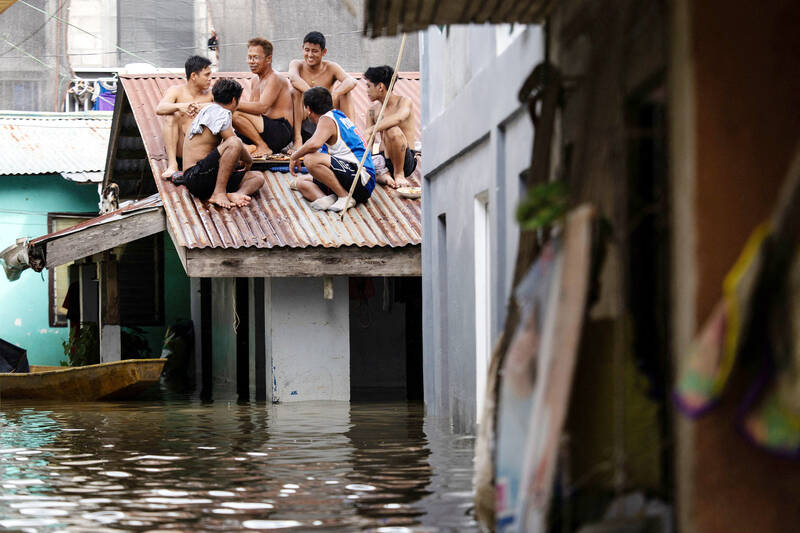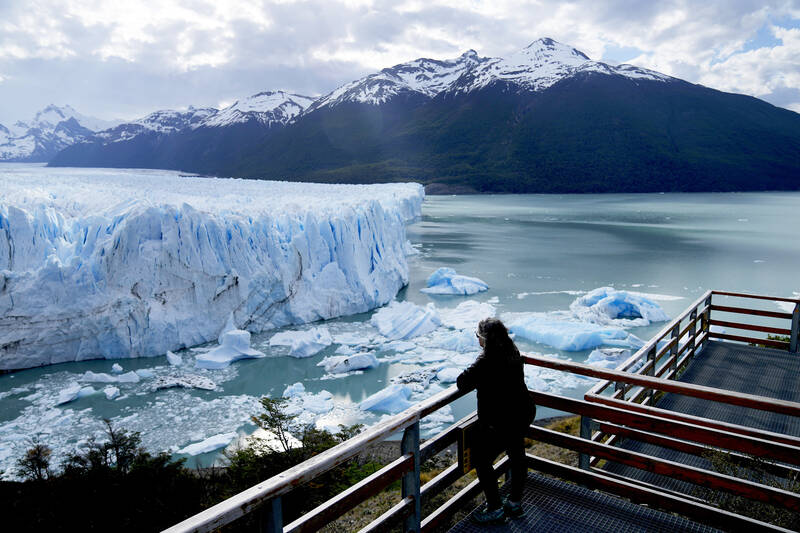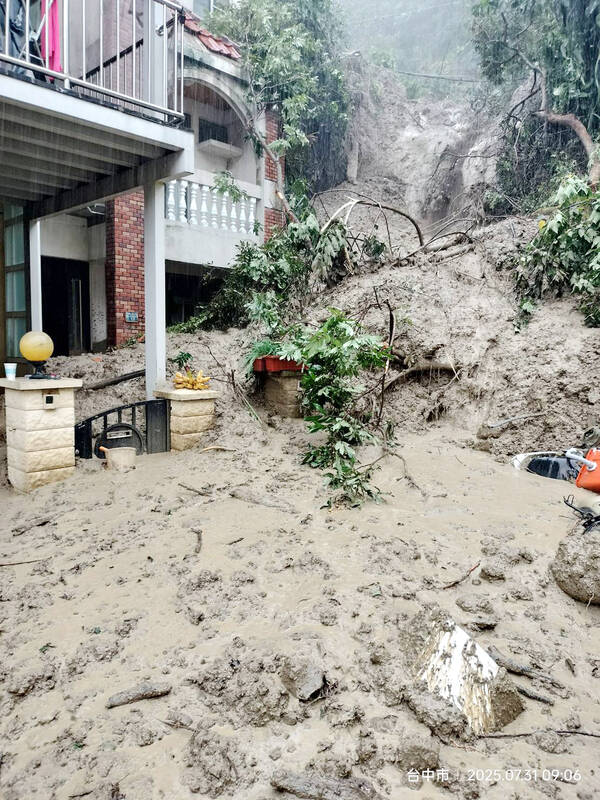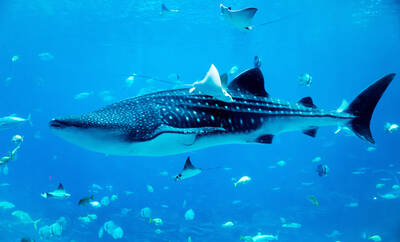The third-hottest July worldwide ended a string of record-breaking temperatures last month, but many regions were still devastated by extreme weather amplified by global warming, the European climate monitoring service said Thursday last week.
Heavy rains flooded Pakistan and northern China; Canada, Scotland and Greece struggled to tame wildfires intensified by persistent drought; and many nations in Asia and Scandinavia recorded new average highs for the month.
“Two years after the hottest July on record, the recent streak of global temperature records is over,” Carlo Buontempo, director of the EU’s Copernicus Climate Change Service, said in a statement.

Photo: Reuters 照片:路透
“But that does not mean climate change has stopped,” he said. “We continue to witness the effects of a warming world.”
A MISLEADING DIP
As in June, July showed a slight dip compared to the preceding two years, averaging 1.25 degrees Celsius above the pre-industrial (1850-1900) era.

Photo: AP 照片:美聯社
2023 and 2024 warmed above that benchmark by more than 1.5C, which is the Paris Agreement target set in 2015 for capping the rise in global temperatures at relatively safe levels.
That deceptively small increase has been enough to make storms, heatwaves and other extreme weather events far more deadly and destructive.
“We continued to witness the effect of a warming world in events such as extreme heatwaves and catastrophic floods in July,” Buontempo said.

Photo courtesy of Village Chief Tseng Chao-huang 照片:曾朝煌里長提供
Last month, temperatures exceeded 50 degrees Celsius in the Gulf, Iraq and — for the first time — Turkey, while torrential rains killed hundreds of people in China and Pakistan.
In Spain, more than a thousand deaths were attributed by a public institute to the heat in July, half as many as in the same period last year.
The main source of the CO2 driving up temperatures is well known: the burning of oil, coal and gas to generate energy.

Photo courtesy of Highway Bureau 照片:公路局提供
“Unless we rapidly stabilise greenhouse gas concentrations in the atmosphere, we should expect not only new temperature records but also a worsening of impacts,” Buontempo said.
REGIONAL CONTRAST
Global average temperatures are calculated using billions of satellite and weather readings, both on land and at sea, and the data used by Copernicus extends back to 1940.
Even if July was milder in some places than in previous years, 11 countries experienced their hottest July in at least a half-century, including China, Japan, North Korea, Tajikistan, Bhutan, Brunei and Malaysia, according to AFP calculations.
In Europe, Nordic countries saw an unprecedented string of hot days, with more than 20 days above 30 degrees Celsius across Finland.
More than half of Europe along with the Mediterranean region experienced the worst drought conditions in the first part of July since monitoring began in 2012, according to an AFP analysis of data from the European Drought Observatory (EDO).
In contrast, temperatures were below normal in North and South America, India and parts of Australia and Africa, as well as in Antarctica.
SEAS STILL OVERHEATING
Last month was also the third-hottest July on record for sea surface temperatures. Locally, however, several ocean records for July were broken: in the Norwegian Sea, in parts of the North Sea, in the North Atlantic west of France and Britain.
The extent of Arctic sea ice was 10 percent below average, the second lowest for a July in 47 years of satellite observations, virtually tied with the readings of 2012 and 2021.
Diminishing sea ice is a concern not because it adds to sea levels, but because it replaces the snow and ice that reflect almost all the sun’s energy back into space with deep blue ocean, which absorbs it. Ninety percent of the excess heat generated by global warming is absorbed by the oceans.
In Antarctica, sea ice extent is the third lowest on record for this month.
(AFP)
歐洲氣候監測機構上週四表示,今年7月的全球溫度是史上第三高,連續打破了多項紀錄,7月過去了,因全球暖化而加劇的極端天氣,仍在許多地區造成嚴重災情。
暴雨淹沒了巴基斯坦與中國北方;加拿大、蘇格蘭和希臘努力控制因持續乾旱而加劇的野火;亞洲與北歐多國創下了當月平均氣溫新高。
歐盟「哥白尼氣候變化服務中心」主任卡洛‧布翁坦波在聲明中指出:「在有史以來最熱的7月過去兩年後,如今全球高溫的連續紀錄終止了。」
他補充說:「但這並不代表氣候變化已經停止,我們仍在目睹全球暖化的影響。」
降溫的假象
與6月相似,7月的平均氣溫雖較前兩年略降,仍比工業化前時期(1850-1900)高出攝氏1.25度。
2023與2024年的升溫更超過1.5度—這是2015年《巴黎協定》為全球升溫所設定的安全上限。
這看似微不足道的升幅,足以讓風暴、熱浪與其他極端天氣事件更致命、更具破壞力。
布翁坦波指出:「我們在7月繼續看到全球暖化的影響,例如極端熱浪與毀滅性洪災」。
上月,波斯灣、伊拉克及土耳其(史上首次)氣溫突破攝氏50度,而中國與巴基斯坦的豪雨奪走數百條人命。
在西班牙,公共機構統計顯示,7月與高溫相關的死亡人數超過一千人,雖然僅為2024年同期的一半。
造成氣溫升高的主要二氧化碳來源眾所周知:燃燒石油、煤炭與天然氣以生產能源。
布翁坦波警告:「如果我們不能迅速穩定大氣中的溫室氣體濃度,不僅會出現新的高溫紀錄,氣候影響還會進一步惡化」。
地區差異
全球平均氣溫是利用數十億筆陸地與海上的衛星及氣象數據計算而得,哥白尼中心所用的資料可追溯至1940年。
儘管某些地區7月較前幾年溫和,但據法新社計算,仍有包括中國、日本、北韓、塔吉克、不丹、汶萊及馬來西亞等11國,創下至少半世紀來最熱的7月的紀錄。
在歐洲,北歐國家經歷前所未有的連續高溫日,芬蘭全國更有超過20天氣溫高於攝氏30度。
根據法新社分析歐洲乾旱觀測站(EDO)數據,今年7月上半,歐洲超過一半地區及地中海區域經歷自2012年有紀錄以來最嚴重的乾旱情況。
相對之下,北美、南美、印度、澳洲及非洲部分地區,以及南極洲,氣溫則低於常態。
海洋仍過熱
上個月的全球海面平均溫度同樣創下歷史第三高的7月紀錄。有多個海域7月達破紀錄高溫,包括挪威海、北海部分區域,以及法國與英國以西的北大西洋。
北極海冰範圍比平均值低10%,是衛星觀測47 年來7月的第二低,與2012年和2021年的紀錄幾乎持平。
海冰減少令人擔憂,不是因為它直接導致海平面上升,而是因為原本能將陽光幾乎全數反射回太空的冰雪,變成了吸收熱量的深藍色海水。全球暖化所產生的多餘熱量,有90%被海洋吸收。
在南極洲,今年7月的海冰範圍則為史上第三低。
(台北時報林俐凱編譯)

A: The news says comic superstar Snoopy’s birthday is coming soon on Aug. 10. B: So he’s a Leo, and his birthday will fall on this Sunday. A: Cartoonist Charles Schulz created the comic strip Peanuts, featuring Snoopy, in 1950. And this year marks the character’s 75th anniversary. B: No wonder there are some big celebrations in Japan, Hong Kong and elsewhere. How about Taiwan? A: The “How Do You Do, Snoopy?” exhibition is taking place in Taipei. Let’s go to Shin Kong Mitsukoshi Department Store’s A11 branch to see the show. A: 新聞說,卡通巨星史努比的生日是8月10日耶。 B: 原來史努比是獅子座,本週日就是他的生日。 A: 漫畫家查爾斯舒茲1950年在《花生》漫畫創造了該角色,今年正好歡慶75週年! B:

When you think of the Netherlands, images of tulips, windmills, and iconic wooden shoes — known as “Dutch clogs” — may come to mind. These traditional shoes are rich in cultural significance. For centuries, Dutch clogs have been admired for their sturdy design and impressive craftsmanship, making them a fascinating symbol of Dutch heritage. Dutch clogs date back to the Middle Ages. During that time, farmers and laborers needed durable shoes to cope with the region’s damp and unpredictable climate and topography. Crafted from solid wood, such as willow or poplar, clogs offered outstanding protection. Their firm structure kept

A: Apart from the “How Do You Do, Snoopy?” exhibition, the Penghu International Fireworks Festival displayed some Snoopy-themed balloon installation art. B: The Yilan International Children’s Folklore & Folkgame Festival also displayed a giant rubber “Snoopy Duck.” A: And Starbucks, Kura Sushi and 7-Eleven are all selling Snoopy-themed products. B: Starlux Airlines even launched new Snoopy-themed flights recently. Isn’t that cool? A: Taiwanese love Snoopy so much. Happy 75th birthday, Snoopy. A: 除了《How Do You Do, Snoopy?花生漫畫75週年特展》,澎湖海上花火節展出了史努比氣球裝置藝術。 B: 而宜蘭國際童玩藝術節,則展出了巨型「史努比鴨」。 A: 星巴克、藏壽司、7-Eleven也推出了史努比聯名商品。 B: 星宇航空今年更推出全新「Snoopy主題航班」,很酷吧? A: 台灣人好愛史努比啊,75歲生日快樂!

Whale sharks are the largest species of fish in the world. They aren’t related to whales, but take their name due to their enormous size. At full maturity, whale sharks measure around nine or 10 meters long and can weigh from 15,000 to 40,000 kilograms. Whale sharks live in warm waters, with about 75% of them found in the Indo-Pacific region. They can migrate thousands of kilometers to different feeding grounds, but at a slow speed of 5 km/h on average. Whale sharks have a broad, flat head and are typically brown or gray in color. Their distinguishing characteristic